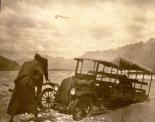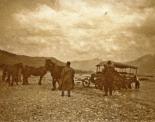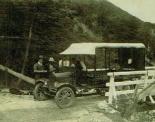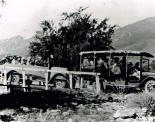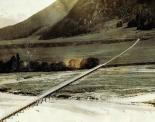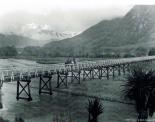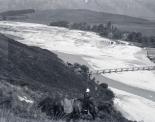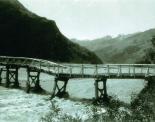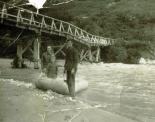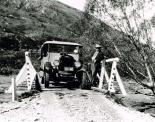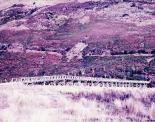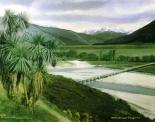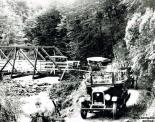THE OLD REES RIVER BRIDGE Gallery
THE OLD REES RIVER BRIDGE
Imagine life before 1921. You want to go up to Paradise for a family picnic, but to get there means fording the Precipice (which isn’t too hard) and then fording McConachy’s, Temple Burn, and the Oxburn before finally finding a shallow enough place to cross the Rees. And then there’s still the Earnslaw Burn on the other side. On horses not too difficult, but with the advent of automobiles at the Head of the Lake, the necessity for bridges grew even more intense as you can see from some of these photos that we’re able to share thanks to the Lakes District Museum and some photos from our own collection.
In 1918 a proposal was put forward to council for a route to connect Paradise to the Rees Valley Road. As you can see from the Engineers proposal below, the idea was to build bridges across the Oxburn, Rees, and Earnslaw Burn and then to acquire enough land from the farmers at the base of Mt. Earnslaw to be able to connect the road all the way through. The Kennett brothers and the Woodleys (who were farming Earnslaw) were all amenable but Charlie Haines at Camp Hill objected and a route had to be found that would satisfy all. Charlie Haines was quite a character so reading between the lines of the Councillor’s report at the time, he certainly didn’t make it easy for them.
By 1919 construction was under way. The Rees Bridge was built entirely of red beech, which was sourced from nearby forests but it was sometimes difficult to find sufficient timber to the standard they required. The bridge, when complete, was 860 feet in length, made up of 48 spans of 20 feet each. Working under the auspices of a Mr S.S. Auburn (who had famously also produced the Lower Shotover Bridge among others…) working for the Public Works Department, the bridge took 2 years to complete. Below you can see the Public Works estimates for 1919 and 1920. Exceptional years in funding major bridge construction at the Head of the Lake!
1919 District Public Works:
Rees River Bridge and Road: 2850 pounds
Earnslaw Burn Bridge: 500 pounds
Oxburn Stream Bridge: 100 pounds
Mt Earnslaw Road: 50 pounds
Paradise to Routeburn via Lake Sylvan: 50 pounds
The 1920 District Public Works:
Rees River Bridge: 1800 pounds
Rees River Road Deviation: 2000 pounds
Glenorchy to Paradise Earnslaw Burn Bridge: 600 pounds
Paradise to Routeburn via Lake Sylvan: 50 pounds
Oxburn Stream Bridge: 165 pounds
Glenorchy to Mines (new tracks): 265 pounds
Both years also includes an interesting one…
Head of Lake Wakatipu to Milford Sound, via Cleddau Saddle: 400 pounds
As the road and bridges opened in November 1920, a newspaper article from “Horatius” pointed out that though the bridges were all very good, only the smallest of cars could negotiate the corners to be able to get onto them and if they were meant for the tourist vehicles, well, it would take a minimum of 15 minutes for them to maneuver themselves onto the bridges. Clearly, there were some growing pains, but eventually, it all was worked out.
The bridges and route improved access dramatically for those who were going up to Paradise and made access in and around the Head of the Lake far easier.
The old Rees Bridge was not indestructible. Knowing how fierce the Rees can be in flood, it’s remarkable that it managed to last more than 30 years in its original site. Tommy Thomson’s Mt. Earnslaw Station diary records on 2 February 1952:
Feb. 2 Sat. Rain stopped at 3am.
One of the worst floods has taken place at the Head of the Lake. The Rees Bridge has collapsed, & many parts of the road washed out.
Throughout the 1950s plans were made for a new Rees Bridge, the bridge we have today. We’ll save its story for another day, but if you’re driving up the Rees Valley and you look out over the river towards Lover’s Leap, you can still see the pilings from the original Rees Bridge. The new Rees Bridge opened on 12 March 1958.
The photos this month include cars going over all of the bridges that were part of the 1918-1921 bridge building project. The new road spanned 3 ½ miles (5.6km) and made it all the more possible to come up on the Earnslaw, make a daytrip up to Paradise and still take the boat home in the same day.
We hope you all had a good Easter. Now that the days are growing shorter, be on the lookout for a night of Historic Films coming this winter. We’ll look forward to seeing you all there.
Engineer’s Report on the Proposed Rees Bridge 16 July 1918
Rees Bridge Article from the Lake Wakatip Mail 4 May 1920
Councillors visit the new Rees Bridge and Road from the Lake Wakatip Mail 14 October 1920


